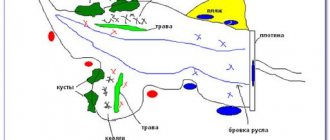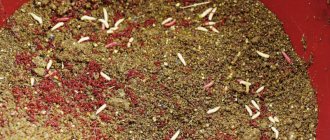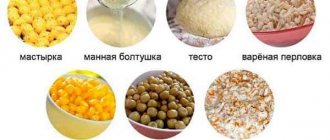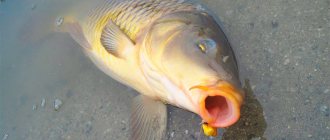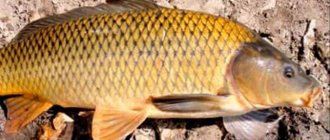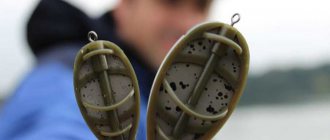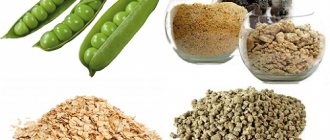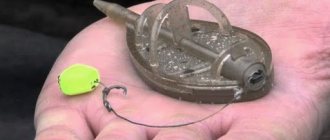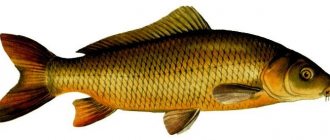Benefits of potatoes for carp fishing
The main advantages of potatoes are their high nutritional value, safety for the health of fish (subject to sport fishing) and the presence in its composition of a huge amount of starch, which carps simply adore (proven by scientists).
Other, no less important advantages:
- potatoes are one of the most accessible materials for bait (besides, they are easy and quick to prepare);
- potatoes have a natural/attractive aroma, as well as the “correct” color (considering the carp’s “love” for muddy water);
- the potato bait can be given any shape and size (for catching small or strictly large carp);
- and what is important is that the potatoes fit comfortably onto the hook and hold tightly to it.
How to choose the right potatoes for fishing?
Naturally, it must be normal, that is, not frozen, moldy, rotten or diseased. The ideal option is to buy potato tubers at a regular market, and not in a supermarket. Because “store-bought” vegetables are not only full of nitrates (and other additives for rapid growth), but can also be treated with special substances for long-term storage. Remember that carp has an excellent sense of smell and delicate taste.
Another, no less “crackling” question that faces anglers (who have not previously used potato baits for catching carp): do you need young or old potatoes? Which one will be better? The optimal choice is precisely old potato tubers (meaning not “last year’s”).
- Firstly , such potatoes were in the ground for a long time, so they managed to absorb a lot of useful elements that simply “fragrant” to the carp;
- Secondly , tubers from the old harvest are more rigid, which means they are more convenient for giving the desired shape, and are as reliable as possible in “work” (i.e., fishing).
How to cook potatoes for carp fishing
Now let's discuss the following question: how to properly cook potatoes for carp fishing? Are there any nuances or is everything as usual, for example, for your own lunch? There are no significant differences, except that it is better to boil the potatoes in their skins and slightly “undercook” them. That is, it should be pierced “tighter”. Thus, it will retain more useful substances, and it will not fall apart even with a powerful cast. How long does it take to cook? No more than 10 minutes, depending on the size of the tubers.
Don’t forget to leave some of the potatoes for puree, which will then need to be added to the bait.
Boiled potatoes on the table, what to do next?
What kind of potatoes should I use?
is of great importance - the number of bites and, as a consequence, the result of fishing directly depends on this.
Under no circumstances should you take tubers that are moldy, rotten, green in the sunlight or have withstood freezing. The fruit must be firm and juicy and not have an unpleasant odor. It can vary in size, but it is most convenient to cut the bait from tubers approximately the size of a tennis ball.
In the summer, many fishermen have a completely logical question - which potatoes will be more effective - the old or new harvest. If the root crop is well preserved, has not withered or been frozen, then it is better to use the old tuber, as it contains more starch and nutrients, which plays a decisive role in its attractiveness to carp . In addition, young potatoes are less dense and will stay on the hook much worse.
How to make potato tips?
- Peel the potatoes and carefully cut them into cubes . Particular evenness is not important here, but it is desirable that the width of the edges should not be more than 3 centimeters or less than 1 centimeter. In this case, the principle applies: the larger the carp you plan to catch, the larger the “cube” should be. All this can be done while fishing, taking whole tubers with you.
- The next option for potato hook attachments is “cylinders” . For this purpose, the most convenient tool would be a regular medical syringe with the top cut off. Next, we pierce the “potato layers” of the required width with it and push out neat “cylinders” using a piston. You can see how this looks in practice in the video (below).
How to cook potatoes for carp and carp
Although boiling potatoes is a very simple process, it is important to know and follow some nuances when preparing them. The recipe for cooking potatoes for carp fishing is as follows:
- Select large, smooth tubers and wash them along with the peel. You should not peel the potatoes, as the water will make them loose.
- Throw the potatoes into boiling water and cook until almost done . The toothpick should enter the tuber with some effort. It is better to undercook a tuber than to overcook it.
- Drain the water and cool the tubers.
- Peel the potatoes and cut into pieces.
- Fry the nozzle in unrefined sunflower oil until light golden brown. Frying is not a necessary process, but this way the bait will be better held on the hook, and the smell of sunflower oil will increase its attractiveness to fish.
Important! When frying potatoes, you should never allow them to burn, as this smell will repel the carp and significantly reduce the number of bites.
Some fishermen use natural flavors by adding garlic or dill to the water when cooking. You can also use concentrated aromatic additives - anise, strawberry, chocolate and others, selecting them to suit the taste preferences of the carp at certain times in different bodies of water.
Sometimes potatoes are tinted in different colors, in the belief that such a move will increase their attractiveness to carp, but many carp fishermen have noted that the color of potatoes plays a role only in some individual reservoirs . There is also a risk that the smell of the dye will be unpleasant for the carp.
Attention! It is not recommended to use potato dyes in spring and autumn.
What bait is needed for potato bait?
It is definitely worth noting that when fishing for carp with potatoes, the bait should also be strictly natural. This can include various porridges, peas, corn, and best of all, corn. Naturally, with the addition of mashed potatoes, which can be made in advance or on the spot (with hands moistened with water from a pond).
You can also use store-bought finely dispersed/low-calorie mixtures, for example, in combination with flavoring agents that release delicious cereal or vegetable odors. But in this case, the carp can be “spoiled”, and it will no longer pay attention to your simple potatoes.
Groundbait in the form of potatoes
As for the nozzle, everything is clear. It is quite simple to make and use
However, we should not forget about one more important nuance – bait. Often you just can’t do without it
Read Zherlitsa with your own hands
Some anglers make an irreparable mistake. They feed the carp with various delicacies, and then they believe that it will start pecking at the potatoes. This will not happen, you should think about this in advance.
If a fisherman doesn’t know what to look for, then he should take a closer look at options such as:
- All kinds of cereals.
- Cake.
- Bran.
- Various bait mixtures (low-calorie).
- Corn.
Of course, all these products are not used independently, but in combination with potatoes, which will be used directly as an attachment. In this case, you need to make a puree from the root vegetable, adding the ingredients described above. On the one hand, such a delicacy will interest the fish, on the other hand, it will arouse its appetite even stronger when it swims next to the tackle.
If possible, flavorings should be added to complementary foods. These can be sunflower seeds, flaxseed oil, corn, dill and much more that is on hand and that you don’t mind putting into action.
Equipment for catching carp with potatoes
The best gear for catching carp with potato baits (or any other) are carp rods designed specifically to catch these incredibly powerful and heavy fish. However, for a catch less than 5 kg in weight, feeders (fast action / dough, at least 150 g) are also perfect. The optimal reel option is with a “baitrunner” system (with a front, or better yet, two rear clutches: fine and coarse).
We choose fluorocarbon as the leader material (in sections of 20-30 cm). When used as the main fishing line - a cord (and not a classic monofilament), it is better to make leashes with a shock absorber (feedergam). Hook sizes: “troika” - according to the Euro standard or 8.5 according to the Russian numbering (with a wide “hook” and a short shank).
Special baits for carp
Boyle
Today there are two types of special carp baits on sale. These are boilies and pellets (granules). Boilies are balls with a diameter of 5-30 mm, consisting of a mixture of various components that attract fish, flavorings and adhesives, and have also undergone special heat treatment.
Such baits can be attached directly to the hook, but most often they are attached to a “hair” in a special hair rig. It involves placing the boilie in close proximity to the hook, in such a way that the carp swallows the bait, which is safe for itself, and the bare hook, following it, enters the fish’s mouth unnoticed.
The composition of boilies must include flour (corn, soy or semolina), which is the basis of the mixture. Ground cereals, eggs or egg powder, bone or fish meal, starch, casein, gelatin, as well as various natural or synthetic attractants (flavors) are added to it.
The international classification of boilies classifies them according to their composition:
- meat containing bone or blood meal;
- fish - with the addition of fish meal or crustacean meal;
- spicy – containing garlic, onion, cumin, vanilla, etc.;
- fruit - with the addition of pulp of apples, plums, bananas, strawberries, pears, etc.;
- sweet – containing caramel, sugar;
The components are mixed in the required proportions and boiled in water or dried until a hard upper crust is formed, which does not allow the bait to become soggy in the water. Depending on the heat treatment process, boilies are divided into several types:
- floating - with a density less than that of water, which allows them to float;
- neutral buoyancy - with a density close to the density of water, allowing it to stay in the flow;
- sinking - with a density greater than water, which makes them sinkable;
The first type of boilies is designed for surface fishing. Such baits undergo minimal heat treatment, and a surface crust is formed during the drying process. Neutral boilies are used for fishing in deep water. The formed balls are boiled to a certain extent, allowing the bait not to encumber or lighten the tackle. Sinking boilies are used for bottom fishing. They go through a long cooking process until the mixture becomes heavy and a thick crust forms on the surface. The finished balls are painted a certain color.
Dusting boilies
There are also special dusting boilies designed for baiting fish. They quickly dissolve in water, forming an alluring “cloud” of mixture particles.
In markets and fishing stores you can buy boilies of various types, sizes and purposes. The most popular baits among carp anglers are the following manufacturers:
- Richworth;
- TandemBaits;
- DynamiteBaits;
- Zoom;
"Skopex"
Among the flavorings used in the manufacture of boilies, the ones that have proven themselves to be the best for carp fishing are:
- strawberry;
- plum;
- "skopex";
- a pineapple;
- "octopus";
When going for carp in a pond where they are constantly caught, it is better to ask the fishermen about their preferred bait. This will eliminate unnecessary costs for various types of bait.
When independently selecting and preparing various baits, keep in mind that:
- a maggot that is stored in a warm place becomes a pupa after 2 days;
- when buying canned products for bait, as well as ready-made boilies, it is better to give preference to well-known manufacturers;
- boiled corn, peas, potatoes should be stored only in the refrigerator and for no more than 2 days - a fermented product will certainly repel carp;
- when cooking boilies of your own making, they must be immersed exclusively in boiling water, otherwise they will simply dissolve in the water;
Make it a rule, on every fishing trip, the first thing you do is...
How to choose a place to catch carp using potatoes
In fact, choosing the “right” place for catching carp with potatoes is no different from choosing a place for any other type of vegetable bait. The main thing is to follow the basic rules of “intelligence.” For example, when fishing for carp in the coastal zone, try to find places where there will be fewer “competitors” (that is, fishermen) or noisy / vacationing companies.
And even better, absolutely not “comfortable” sites for placing a person, according to the old fishing principle: the worse it is for the fisherman, the better for the fish (and your chances will increase sharply). Look for fallen trees, snags, water lilies, and accumulations of aquatic vegetation. Don't stand against the sky for too long. Choose clothes strictly to match the color of the landscape (the best option is special camouflage).
Tactics for catching carp using potatoes
As a rule, most experienced carp fishermen have a variety of tactics, methods and methods of carp fishing in stock. And not only for potatoes, but also for many other grain baits, which they won’t tell anyone about. But what about beginners? So, for those who have recently decided to take the path of fishing, we offer a classic plan of action. So let's get started.
- First of all, we conduct reconnaissance of the area to identify the most promising place for our fishing. We wrote above how best to do this.
- Next, after setting up the “camp”, we prepare the bait. Be sure to dilute it in water from the reservoir (and not in your own, i.e. brought in). We add local soil there and start feeding.
- Immediately after baiting the future fishing point, we check the “combat readiness” of our gear, while paying special attention to the fishing line (knots, abrasions, etc.).
- Now it's time to put the potatoes on the hook. Carefully pierce the center of one of the sides of the cube or the base of the cylinder with a sting, and remove it from the side. It is better to “tighten” the tip of the hook a little inside the potato. You can watch the video below to see how to properly place potatoes on a hook.
- After this, we smoothly throw our gear to the fishing point, fix the rod on the shore and... wait for the bite. Just in case, we check once again whether everything we need when landing fish (especially landing nets) is at hand.
- If the carp does not bite for a long time (approximately more than an hour), then we change the potato bait to a new one, in order to avoid it coming off (the potatoes may get wet in the water). We make sure that the container with bait does not lose its seal or is not exposed to direct sunlight.
- It is important to know that carp never swallows the bait right away, since first it “analyzes” it for edibility, as if savoring it in its mouth. Therefore, at the slightest “ringing” of the signaling device, you should not immediately jump nervously. We are waiting for confident breakthroughs.
- When landing carp on the shore, it is necessary to constantly tire it, periodically releasing the fishing line (within reasonable limits). The rest of the work is done with a quick rod action.
- When the fish is nearby, we use a landing net and (as they say) we are not afraid to get our clothes wet.
- You should not handle the carp with dry hands, as at this moment it will feel something similar to burns (when the protective mucus on its sides is “erased”).
How to properly place potatoes on a hook - video
Publication author
offline 7 months
How to put potatoes on a hook
There are also several options here, among which there are more effective and simpler ones - you can choose which one to use. Let's look at both methods.
The easy way. Although it is simple, it is still effective. In this way, pieces of potato, which we cut into cubes or cylinders using a syringe, are placed directly on the hook. The sting can be either hidden in the body of the bait or left open. It is advisable to try to put a potato with an open sting on one tackle, and try to hide it on the other. On some reservoirs, carp are extremely suspicious of hooks protruding from the bait, and on others they do not pay attention to it. If the potatoes are overcooked, they will break off the hook, so the ideal potato for this method of baiting is undercooked. It still remains quite soft and the carp usually successfully clings to the hook when biting.

